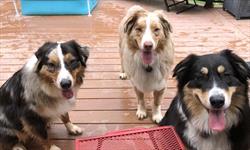Christine D. Calder, DVM, DACVB
2 border collies.png

Photo Courtesy of Pat Koven LVT, KPA-CTP
What is “Littermate Syndrome”?
Also known as littermate dependency, this term refers to behaviors that develop when two puppies from the same litter are raised together. Behaviors include attachment to each other, difficulty bonding with humans and other animals, aggression, separation anxiety, and reduced independence in training. This pattern is believed to occur with any pair of puppies or dogs that are raised together at the same time, whether they are siblings or not.
The concept of littermate syndrome is a topic of discussion among dog trainers, shelter personnel, breeders, and other animal professionals. However, this syndrome is not recognized by veterinary behaviorists or other leading experts in the field. Instead, the behaviors associated with this “syndrome” are more likely related to the challenges of raising two puppies together.
If this “syndrome” isn’t real, why do these behaviors occur?
In general, raising one puppy can be time-consuming. Teaching social skills, housetraining, socialization, management, and training is challenging enough with just one puppy - imagine doing all of this with two. When working with two puppies, it is difficult to ensure that each puppy has their own unique experiences independent of the other.
Socialization
During the socialization period, puppies learn about new things in their environment, the human world, other animals, and so much more. The quality of each new experience is important. Each puppy needs to feel safe and is given ample time to explore and make associations at their own pace in a positive yet controlled manner.
Housetraining
Housetraining is an essential aspect of raising a puppy. It involves teaching puppies to eliminate in designated areas and develop good bathroom habits. With direct supervision, positive reinforcement, frequent opportunities to eliminate, an established routine, and a little patience, most puppies catch on quickly, but not all. Each puppy will be different, and therefore two puppies going through the housetraining process at the same time may be frustrating for all.
3 border collies.jpg

Photo Courtesy of Pat Koven LVT, KPA-CTP
Redirecting Less Desirable Behaviors
Puppies will chew, nip, jump, and demonstrate other nuisance behaviors. Redirection is often key, and “puppy proofing” is essential. Enrichment in the form of food-stuffed puzzle toys, adequate exercise, rest periods, and positive reinforcement training can reduce all of these behaviors and help puppies make better choices. Capturing desired behavior helps to build healthy bonds with humans and gives the puppy opportunities to reinforce the behaviors you want to see from your dog. Attempting this with two puppies can lead to missed opportunities or accidental reinforcement of undesirable behaviors.
Training
Training is an important form of learning for both the human and the puppy. This process gives an opportunity for mental enrichment and to teach basic social skills. Behaviors such as “touch”, “come” when called, and how to “settle on a mat” are all important skills for all puppies to learn. Leash manners and learning how to like car rides are equally important. When accomplishing these tasks, working with two puppies will be twice the challenge.
Is there ever a time when two puppies may be better than one?
Yes. Some puppies raised together may form healthy bonds and develop well-adjusted behaviors. If you do choose to raise two puppies together, provide each puppy with separate training, socialization opportunities, and individual attention to promote their overall well-being and balanced growth.
When it comes to littermate syndrome, it is not so much about a lack of bonding with the family or behavioral problems developing when puppies are siblings. It is more about the challenges that come from raising two dogs together simultaneously.